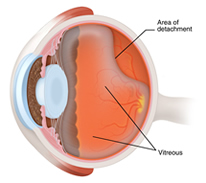Flashes and Floaters
Flashes and floaters of the eye commonly occur as the result of age-related changes to the vitreous gel. At birth, the vitreous is firmly attached to the retina and is a thick, firm substance without much movement. As we age, the vitreous becomes thinner and more watery, and tissue debris that was once secure in the firm vitreous gel is now able to move around on the inside the eye, casting shadows on the retina.
Symptoms of Flashes and Floaters
Flashes that occur in vision are as a result of pressure on the retina, the bundle of nerves in the back of the eye where images are detected and transmitted to the brain, causing patients to see either flashing lights or lightning streaks.
Floaters occur when fibers move across the vitreous and into the field of vision, causing patients to see specks, strands, webs or other shapes as the fibers cast shadows on the retina.
These symptoms are most visible when looking at a plain, light background. Flashes and floaters often appear at the same time, although some patients may only experience one symptom.
Causes of Flashes and Floaters
Flashes may occur after a blow to the head, or from a spasm of blood vessels in the brain, which is associated with migraine headaches. Floaters appear most often in eyes that are injured, inflamed or nearsighted. In these cases, flashes and floaters are harmless symptoms that are not of medical concern.
Flashes and floaters may occur as a result of the following:
- Cataract surgery
- YAG laser surgery
- Diabetes
- Retinitis
- Nearsighted vision
- Eye infections
- A blow to the head
- Blood vessel spasm
- Injury to the eye
Risk Factors of Floaters
 Flashes and floaters appear as the vitreous pulls loose from the retina, creating shadows within the eye. This may indicate that a posterior vitreous detachment (PVD) has occurred. A PVD involves the vitreous gel shrinking and pulling away from the retina. It is most frequently caused by the aging process and therefore is often seen in patients over the age of 60. However, PVD can appear in younger patients, especially in an eye that has Myopia or has sustained an injury or been subject to inflammation. Changes in the symptoms of PVD are important because they can signal a retinal detachment or retinal tear.
Flashes and floaters appear as the vitreous pulls loose from the retina, creating shadows within the eye. This may indicate that a posterior vitreous detachment (PVD) has occurred. A PVD involves the vitreous gel shrinking and pulling away from the retina. It is most frequently caused by the aging process and therefore is often seen in patients over the age of 60. However, PVD can appear in younger patients, especially in an eye that has Myopia or has sustained an injury or been subject to inflammation. Changes in the symptoms of PVD are important because they can signal a retinal detachment or retinal tear.
Diagnosis of Flashes and Floaters
While flashes and floaters are common, especially as we age, it is important to see your doctor if you experience them, as they may indicate a retinal tear or hole. Your doctor can distinguish between harmless flashes and floaters, and those that may require treatment for an underlying condition.
The sudden appearance of flashes, floaters and other visual disturbances may indicate the vitreous pulling away from the retina, leading to a retinal detachment. Anyone experiencing these symptoms should seek immediate medical attention to reduce the risk of complications such as loss of vision.
Most flashes and floaters will become less noticeable with time as patients adjust their vision. While these floaters are harmless, it is important to continue to receive regular eye exams to ensure that any permanent changes to your vision do not occur.
Treatment of Flashes and Floaters
Flashes and floaters are usually harmless and do not usually require any treatment aside from regular monitoring. Patients bothered by the disturbances in their vision or those experiencing significant visual interference may require more advanced treatment.
Treatment to reduce the appearance of flashes and floaters requires surgery to replace the vitreous gel. This procedure, known as a pars plana vitrectomy, removes the natural vitreous and replaces it with fluid. In the case of a retinal detachment, emergency treatment is necessary to prevent serious complications.
Your doctor will determine which treatment is necessary for your individual condition after a thorough evaluation of your eye's health. Most patients with flashes and floaters are able to effectively maintain their vision.

